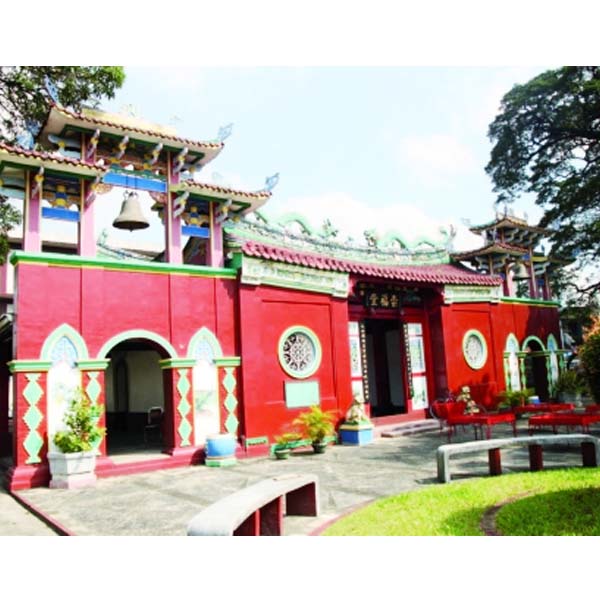The book Himlayan, Pantiyon, Kampo Santo, Sementeryo: Exploring Philippine Cemeteries, edited by Grace Barretto-Tesoro (University of the Philippines Press, 2017), includes a chapter on the “History of the Manila Chinese Cemetery” written by Donna Mae N. Arriola and Eleanor Marie S. Lim.
Arriola and Lim’s comprehensive research is part of the “Exploring Philippine Cemeteries: Alive and Dynamic Spaces” project. They chose the Manila Chinese Cemetery because of “the significance of the Chinese community in the Philippines and their contribution to Philippine culture, society and economy.”
“The Manila Chinese Cemetery,” they pointed out, “is the largest Chinese cemetery in the Philippines with a land area of 54 hectares. It is the second oldest among all existing modern cemeteries in the country, the oldest being the La Loma Catholic Cemetery.”
In the section “The origins of the Manila Chinese Cemetery,” Arriola and Lim cited the article this writer co-authored with Ivan Man Dy. The article appeared in the coffee table book, Tsinoy – the Story of the Chinese in Philippine Life, published by Kaisa Para Sa Kaunlaran in 2005.
One important reference our Tulay readers may be interested in on this subject is “Chinese Tombstones and Tablets in the Philippines: Sources of Historical Information,” co-authored by Richard Chu and Teresita Ang See, as chapter six of The Chinese in the Philippines: Problems and Perspectives, vol. 5 (2018).
Arriola and Lim cited our explanation: “Before the Chinese cemetery was built, non-Catholic Chinese either sent corpses back to China or interred them outside the La Loma Catholic Cemetery, although the exact location is unknown.”
Binondo had its own cemetery in La Loma, and this was a Catholic cemetery with a chapel built in 1884. In fact, the La Loma Catholic Cemetery was formerly known as the Cemeterio de Binondo. It was established in 1840 in order to exclude non-Catholics and outcasts of society from consecrated grounds like those that died from contagious diseases and people who are political enemies of the Spanish Crown.
The campo santo, or field of saints or cemetery, was already in existence in 1846 for the exclusive use of Catholic Chinese.
So, non-Catholic Chinese in Binondo requested for a cemetery of their own. In those times, Chinese who observed Buddhism (non-Christian Chinese, not necessarily Buddhist followers – Ed.) had their burial grounds in Bangcusay in Tondo, located on a hill slope near the San Lazaro, a hospital for those stricken with leprosy.
The plot of land in La Loma was bought by Lim Ong (林旺) in fulfillment of his promise to build a cemetery for the Chinese when he became the elected gobernadorcillo of the sangleyes. The original plot was expanded later on by Don Mariano Fernando Yu Chingco (楊尊親) – subsequent gobernadorcillo.
In 1878, Yu Chingco bought land worth P14,000 to expand the cemetery from the Dominican Provincial which used to own the Hacienda de La Loma from which the cemetery was built. This cemetery catered to poor Chinese who could not afford to return to China to bury their dead or send their bodies.
This account mentioned that the Chong Hok Tong (崇福堂) was originally built as a Chinese-styled Catholic chapel for P33,980. The complete list of expenses for the building of the chapel can be found in the article of Chu and See mentioned above.
Arriola and Lim wrote, “Another version set the date much later, around 1870, but Man Dy and Go (2005) failed to mention the primary source. This account generally resembles the version described above and identified Lim Ong, then capitan of Gremio de Chinos or the Chinese Guild, as one of the personalities instrumental to the creation of the Chinese Cemetery.”
As we failed to mention our primary source in the article cited by Arriola and Lim, we are now doing so: It is the 90th anniversary yearbook of the Philippine Chinese Charitable Association Inc., 1877-1967.
The Chinese Charitable Association is the organization managing the Chinese Cemetery and the accounts in the yearbook were based on their own records.
An article in the yearbook, published in Chinese, states that “…in 1870, Capitan Lim Ong (林旺) of Long Xi, Fujian (福建龍溪) bought a plot of land and donated it for the cemetery. He entrusts it to the Comunidad de Chinos to manage, but it is still under the regulation of Capitan.”
The Comunidad de Chinos is the predecessor of the Chinese Charitable Association.
Categories
The Manila Chinese Cemetery
